PIAA coronagraph design for EXCEDE

PIAA coronagraph design for EXCEDE |
 |
Home |
Show content only (no menu, header)PIAA coronagraph design for EXCEDE1. Overview1.1 IntroductionThe function of the EXCEDE instrument is to deliver an image of the immediate surrounding stars in which companion point sources would be detectable at the 1e-7 contrast ratio at and beyond 1 l/D separation, provided that their apparent brightness is above the EXCEDE point source sensitivity. The EXCEDE instrument achieves this goal by meeting the following following requirements:
1.2 Phase-Induced Amplitude Apodization (PIAA) principleThe EXCEDE coronagraph achieves its high performance (high throughput, strong starlight suppression, high angular resolution and small inner working angle) by using the Phase-Induced Amplitude Apodization (PIAA) technique (Guyon 2003). PIAA performs a lossless beam apodization by geometric redistribution of light with aspheric mirrors rather than the more conventional but poorly efficient shaped masks or partial transmission devices. The EXCEDE PIAA coronagraph architecture is very similar to the Subaru PIAA and Ames testbeds. These testbeds have already exceeded the contrast requirement (1e6) for EXCEDE, and we therefore do not anticipate need to further develop coronagraph technology.1.3 EXCEDE coronagraph designThe coronagraph design adopted for EXCEDE is a Lyot Coronagraph fed by a PIAA front end. The beam from the telescope is first apodized by the PIAA mirrors and an apodizer (narrow concentric rings deposited on a plate of AR-coated fused silica). The focal plane mask removes most (99.98%) starlight, and, just as in a Lyot coronagraph, most of the remaining starlight is then diffracted outside the geometric pupil. Sharing the starlight rejection between the PIAA optics, the apodizer, the focal plane mask and the Lyot pupil plane mask considerably eases manufacturing and also offers higher performance than either a pure-PIAA or a pure-Lyot design. The inverse PIAA M2/M1 mirrors undoes the remapping which has been performed by PIAA M1/M2, and therefore restores a clean diffraction-limited wide field of view for the science camera. Some starlight is reflected by the focal plane mask into the LOWFS. Fabrication of aspheric PIAA mirrors to the requirements of EXCEDE has been validated for the Subaru PIAA testbed. A second set of higher quality PIAA mirrors is currently under manufacturing by a different vendor.1.4 EXCEDE coronagraph performanceThe EXCEDE coronagraph has been designed to offer optimal performance in a 20% wide spectral band. At 1 l/D separation, 25% of the light of a 1e-6 contrast point source companion emerges above the PSF of the central source. 1 l/D can therefore be considered as the practical inner working angle of the coronagraph, beyond which the coronagraph throughput rapidly increases: at 2 l/D separation, 85% of the companion's light is readily detectable.1.5 Wavefront quality requirementsThe wavefront requirements for EXCEDE are summarized in the table below. They are derived to meet the goals set above: 1e-6 raw PSF contrast and PSF stability/calibration to 1e-7 contrast.
1.6 Low Order Wavefront Sensor (LOWFS)The LOWFS uses light reflected by the outside part (from 0.6 l/D to 1 l/D radius) of the focal plane occulter. This light, which would otherwise be lost, is used to measure low order aberrations (Tip/Tilt, Focus, Astigmatism) in the coronagraph by acquiring on the same small format detector inside and outside focus images of the focal plane mask. Thanks to the large number of available photons, and to the fact that only light in the part of the PSF which is most sensitive to low order aberrations is used, the LOWFS provides accurate measurement of pointing, focus and astigmatism within a short exposure time: it takes 1/70 sec to measure pointing at the required 0.5% l/D accuracy, and 1.2 sec to measure focus to the required 1e-3 radian accuracy on a m=10 star (the faintest end of EXCEDE's target list). This measurement serves two purposes, both essential to achieving the full performance of the EXCEDE PIAA/Lyot coronagraph:
2. PIAA/APLC optimization for EXCEDEIn a "pure PIAA" coronagraph, the apodization and focal plane mask size are designed to deliver the required contrast in the first focal plane. The apodization would be chosen such that the PSF radial profile drops below the desired contrast as soon as possible (lowest possible angular separation), and the focal plane mask is simply removing the part of the PSF which is above this contrast level.A more efficient PIAA design is to achieve the required starlight suppression in two steps: the focal plane mask, and a pupil plane "Lyot stop". This is similar to what is done in Apodized Pupil Lyot coronagraphs, except that here, the pre-apodization of the pupil is performed by the PIAA optics. This scheme allows a smaller focal plane mask and improved IWA. In the EXCEDE coronagraph design, the Lyot pupil plane stop can be placed on the inverse PIAA-M2 mirror will act as the Lyot stop, and will simply cut out the light outside the geometrical pupil: for an off-axis source, this Lyot stop has full throughput. While a PIAA/APLC with small focal plane mask offers improved IWA/throughput, it is also more sensitive to (1) pointing errors and (2) chromaticity. The sensitivity to chromaticity is due to the need to carefully adjust the focal plane mask to reach optimal starlight rejection. At 1e-6 contrast, the sensitivity to pointing errors is not too extreme, and sensitivity to chromaticity will therefore drive the PIAA/APLC design. The design for EXCEDE's coronagraph is therefore a compromize between monochromatic performance (smaller focal plane mask is better, offers better IWA/throughput) with chromaticity (better with larger focal plane mask). The design was optimized for a 20% wide band, and the mask size was chosen to offer the same performance at both ends of the 20% wide spectral band. Useful throughput (y axis) as a function of angular separation (x axis) for the red edge (red curve), nominal (green) and blue edge (blue) of a 20% wide spectral band. Note that the nominal wavelength in these figures is not at the center of the spectral band. Nominal mask size = 1.6 : 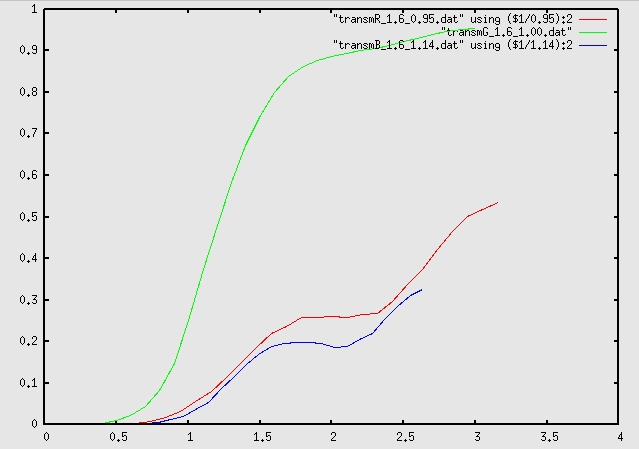 Nominal mask size = 2.0 : 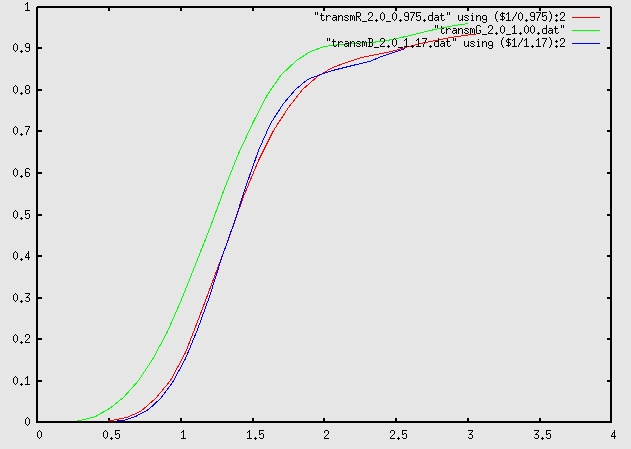 Nominal mask size = 2.4 : 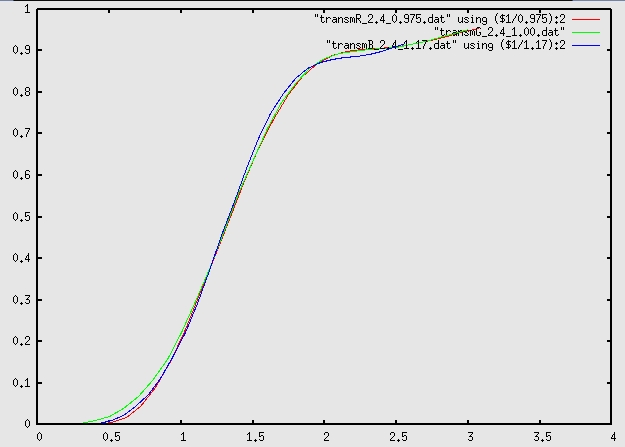 PIAA/APLC design adopted for EXCEDEThe design adopted is the middle one in the 3 figures above (nominal mask size = 2.0). At the design wavelength, the focal plane mask lets 1/2000 of the starlight through, and the Lyot pupil plane lets 1/2000 of this residual through. The combined starlight throughput is therefore 1/4e6 = 2.5e-7.In a 20% wide band, the useful throughput is ~25% at 1 l/D (30% in monochromatic). Sensitivity to pointing errors and stellar angular size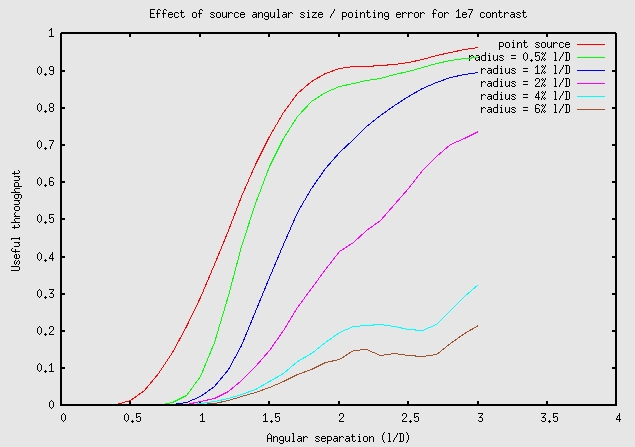 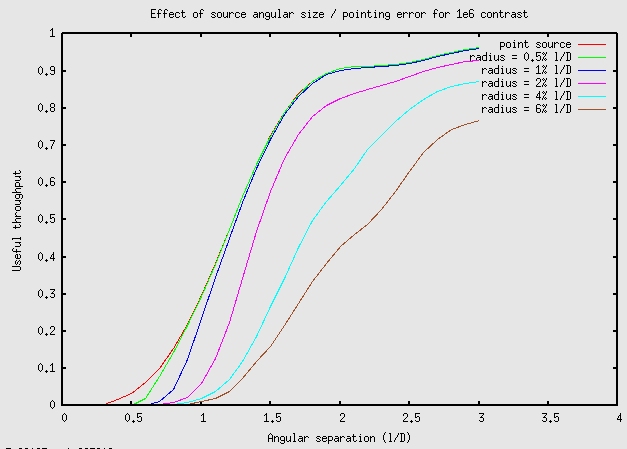 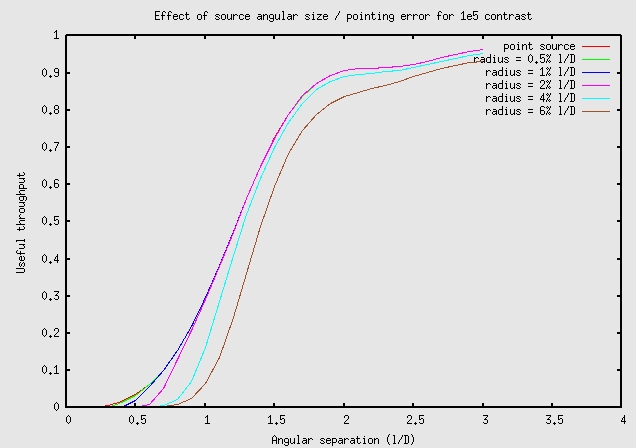 Sensitivity to Focus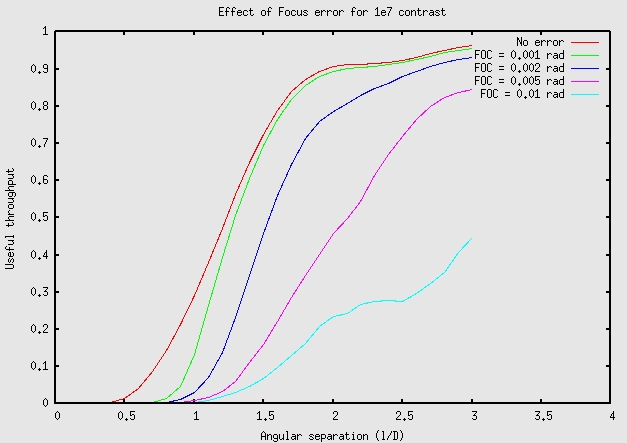 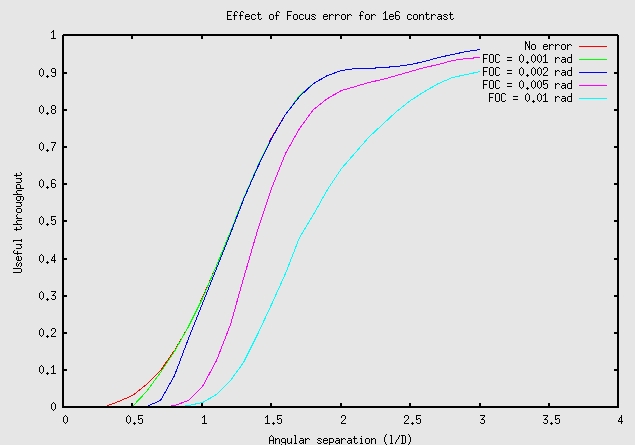 Sensitivity to Astigmatism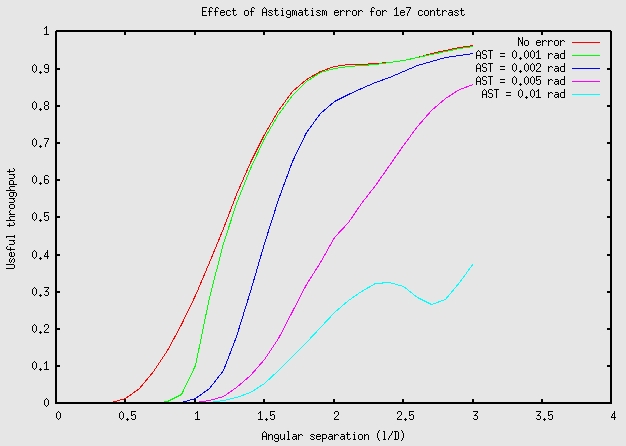  Appendix 1: Apodization functionA1.1 Apodization function tableThe apodization function is a prolate spheroidal function, which was iteratively numerically computed. The mask radius eigenvalue is 2.0.Apodization function numerical table ASCII A1.2 Analytical fit to apodization profile used for EXCEDE PIAAFollowing analytical fit was obtained by fit.c program, and is used in module PIAAlabexpSIMUL:a1b = -2.758451; b1b = 2.003837; a2b = -0.996055; b2b = 5.910419; f(x) = exp(-2.758451*x**2.003837 + -0.996055*x**5.910419) Appendix 2: Choice of apodization profile for a "pure PIAA" (THIS IS NOT THE EXCEDE DESIGN)Find optimal apodization profile for ~1e6 raw contrast. The optimization algorithm tries to minimize the IWA of the apodization profile at the contrast goal specified by the user. Throughput is not explicitely optimized, but IWA minimization does indirectly prevent strong apodization and therefore low throughput. The result profile is "bestprof.dat", and the corresponding PSF is "psfbest.html". The profile can be described by a simple analytical equation similar in form to the one used for PIAA-gen2. Result written "PIAA_diffraction" module, "PIAADIFFRACTION_findProfile1D" function:apo profile is in the form f(r) = exp( a1*pow(r,b1) + a2*pow(r,b2)) a1b = -3.903868; b1b = 2.097357; a2b = -1.096446; b2b = 7.216046;Overall throughput of profile (for non-PIAA apodization) would be 13.62% Appendix 3: Flux calibration for EXCEDEV = 10, 0.4 micron 20% wide filter, specrally flat in f lambda, 12 mirrors each 98.5% reflective, 95% throughput for apodizer, 70% QE: 195 kphe-/sPage content last updated: 27/06/2023 06:35:52 HST html file generated 27/06/2023 06:34:37 HST |